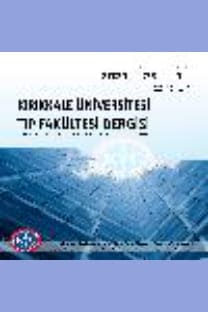MEDİKAL TEDAVİYE DİRENÇLİ KRONİK MİGREN HASTALARINDA BOTULİNUM TOKSİN TİP A UYGULAMASINDAKİ DENEYİMLERİMİZ
Botulinum nörotoksin A, Kronik migren, Numerik derecelendirme skoru
Our Experience in the Application of Botulinum Toxin Type A in Medically Resistant Chronic Migraine Patients
Botulinum neurotoxin A, Chronic migraine, Numeric rate scale,
___
- GBD 2015 Disease and Injury Incidence and Prevalence Collaborators. Disease and Injury Incidence and Prevalence Collaborators. Global, regional, and national incidence, prevalence, and years lived with disability for 310 diseases and injuries.1990-2015. A systematic analysis for the Global Burden of Disease Study 2015. Lancet. 2016; 388(10053):1545-602.
- Headache Classification Committee of the International Headache Society (IHS). The international classification of headache disorders (beta version). Cephalalgia. 2013;33(9):629–808.
- Natoli JL, Manack A, Dean B, Butler Q, Turkel CC, Stovner L et al. Global prevalence of chronic migraine: a systematic review. Cephalgia. 2010;30(5):599-609.
- Mathew NT.Pathophysiology of chronic migraine and mode of action of preventive medications. Headache. 2011;51(2):84-92.
- Blumenfeld A, Silberstein DS, Dodick DW, Aurora SK, Turkel CC, Binder WJ. Method of injection of onabotulinumtoxinA for chronic migraine: A safe, well-tolerated, and effective treatment paradigm based on the PREEMPT clinical program. Headache. 2010 ;50(9):1406-18.
- Tandon M, Singh A, Saluja V, Dhankhar D, Pandey C, Jain P. Validation of a new.objective score vs Numeric Rating Scale fob the evaluaiton of acute pain: A comparative study. Anesth Pain Med. 2016;6(1):e32101.
- Aurora SK, Dodick DW, Turkel CC, DeGryse RE, Silberstein SD, Lipton RB et.al. OnabotulinumtoxinA for treatment of chronic migraine: results from the double-blind, randomized, placebo-controlled phase of the PREEMPT 1 trial. Cephalalgia. 2010 ;30(7):793-803.
- Lv X, Wu Z, Li Y. Innervation of the cerebral dura mater. Neuroradiol J. 2014;27(3):293-8.
- Goldberg SW, Silberstein SD. Targeting CGRP: a new era for migraine treatment. CNS Drugs. 2015;29(6):443-52.
- Binder WJ, Brin MF, Blitzer A, Schoenrock LD, Pogoda JM. Botulinum toxin type A (BOTOX) for treatment of migraine headaches: an open-label study. Otolaryngol Head Neck Surg. 2000;123(6):669-76.
- Diener HC, Dodick DW, Aurora SK, Turkel CC, DeGryse RE, Lipton RB et.al. PREEMPT 2 Chronic Migraine Study Group. Onabotulinumtoxin A for treatment of chronic migraine: Results from the double-blind, randomized, placebo-controlled phase of the PREEMPT 2 trial. Cephalalgia. 2010;30(7):804-14.
- Aurora SK, Brin MF. Chronic migraine: an update on physiology, imaging, and the mechanism of action of two available pharmacologic therapies. Headache. 2017;57(1):109-25.
- Burstein R, Blumenfeld AM, Silberstein SD, Adams MA, Brin MF. Mechanism of Action of OnabotulinumtoxinA in Chronic Migraine: A Narrative Review. Headache. 2020; 60(7):1259-72.
- Bendtsen L, Sacco S, Ashina M, Mitsikostas D, Ahmed F, Pozo-Rosich P et al. Guideline on the use of onabotulinumtoxinA in chronic migraine: A consensus statement from the European Headache Federation. J. Headache Pain. 2018;19(1):91.
- Andrea N, Martina C, Luana L, Paolo M. A two years open-label prospective study of OnabotulinumtoxinA 195 U in medication overuse headache: a real-world experience. J Headache Pain. 2016;17:1.
- ISSN: 2148-9645
- Yayın Aralığı: 3
- Başlangıç: 1999
- Yayıncı: KIRIKKALE ÜNİVERSİTESİ KÜTÜPHANE VE DOKÜMANTASYON BAŞKANLIĞI
Beril DİLBER, Yeşeren DEMİRHAN, Fazıl ORHAN, Ali CANSU
ÇOCUKLARDA BÜYÜME HORMONU TEDAVİSİ: TEK MERKEZ DENEYİMİ
İNMEMİŞ TESTİS NÜKSLERİNDE CERRAHİ DENEYİMLERİMİZ
Cem KAYA, Alparslan KAPISIZ, Ramazan KARABULUT, Zafer TÜRKYILMAZ, Kaan SÖNMEZ
Üçüncü Basamak Sağlık Merkezi Hemoglobin Varyant Verilerinin Üç Yıllık Değerlendirilmesi
İSTANBUL’DA KAMU HASTANELERİNDE SAĞLIK HİZMET SÜREÇLERİNDE BEKLEME SÜRELERİNİN ANALİZİ
Büşra TEYİN, Pakize YIGIT, Olcay ÖZEN, İlker KÖSE, Sabahattin AYDIN
YETİŞKİN KADINLARIN SAĞLIKLI OLMA KÜLTÜRÜNE YÖNELİK TUTUMLARININ İNCELENMESİ
Hakan YAPICI, Döndü UĞURLU, Mehmet GÜLÜ, Ali Ahmet DOĞAN
YOZGAT YÖRESİNDE ALT GASTROİNTESTİNAL SİSTEM ENDOSKOPİ SONUÇLARININ ANALİZİ
